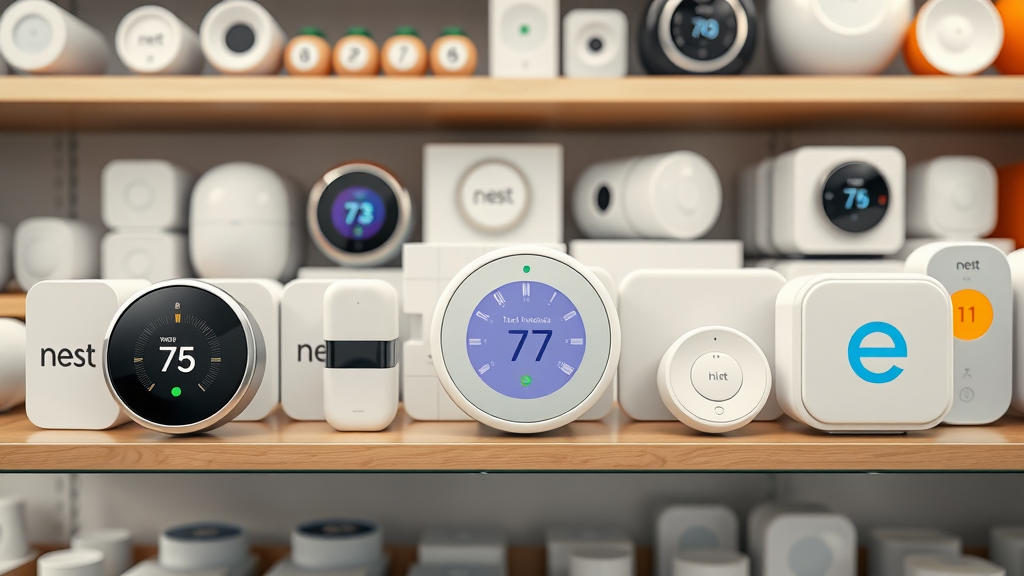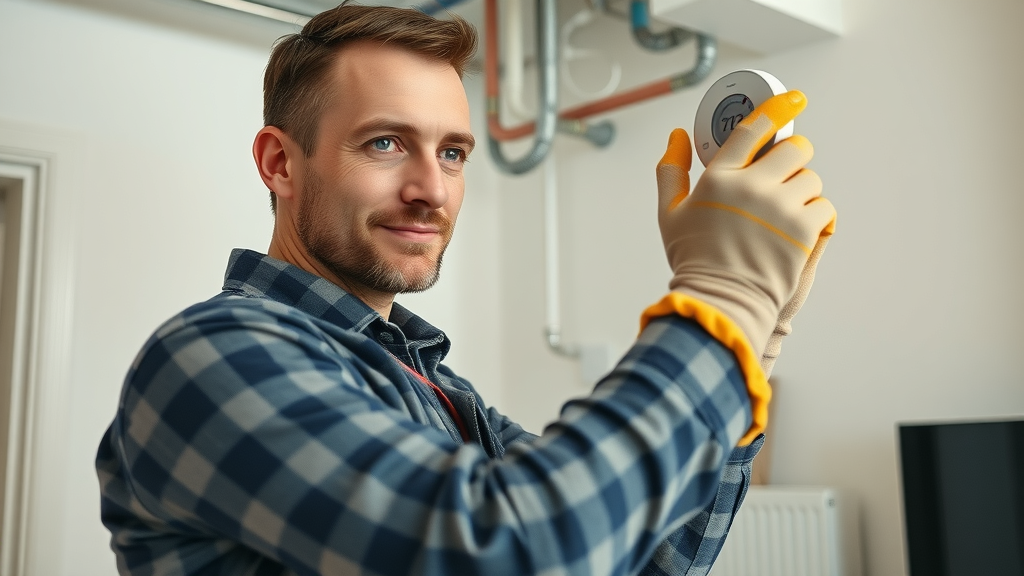Did you know? “Up to 50% of UK homes using smart thermostats report a significant drop in energy bills—are you missing out?” Smart thermostats are quickly changing the way UK home and business owners control their heating and hot water. With just a few taps on your phone (or a simple voice command to your smart speaker), you can adjust the temperature in your home, reduce your energy use, and save money. This guide is for you if you’re ready to enjoy the benefits—or fix the headaches—of smart thermostat technology.

A Startling Fact: Why Smart Thermostats Matter for UK Homes and Businesses
Smart thermostats are more than just gadgets—they’re smart investments for UK homes and businesses seeking energy savings, comfort, and convenience. The typical British household spends hundreds of pounds annually on heating, and with rising fuel prices, managing your heating system efficiently matters more than ever. Smart thermostats such as the Nest Learning Thermostat, Hive Thermostat, and E Smart Thermostat empower users with tools to control your heating, create custom schedules, and even coordinate with other smart home devices.
Business property owners can also benefit. With multi-zone support, smart radiator valves, and integration with smart assistants like Amazon Alexa or Apple HomeKit, the temperature in your home (or every office) stays perfectly comfortable. Looking to cut costs, improve comfort, or streamline automation? Upgrading to a smart thermostat could be your first step to a warmer, more efficient, and smarter property.
“Up to 50% of UK homes using smart thermostats report a significant drop in energy bills—are you missing out?”

What You’ll Learn About Smart Thermostats
- How smart thermostat technology improves comfort and efficiency
- Common problems with smart thermostats and rapid fixes
- Top models including Nest Learning Thermostat and Hive Thermostat
- Setup, troubleshooting, and integration with Amazon Alexa and Apple HomeKit
- Choosing the best smart thermostat for UK properties
Understanding Smart Thermostats: Features, Benefits, and How They Work
What Does a Smart Thermostat Do?
- Automation and remote control for your heating system
- Learning thermostat features: scheduling, sensors, and app integration
- Connectivity with Apple Home, Amazon Alexa, and more
A smart thermostat is a game-changer for managing your home’s heating and hot water. Unlike old-fashioned thermostats, smart thermostats connect to your Wi-Fi, letting you adjust the temperature using your mobile, tablet, or smart speaker—wherever you are. With smart home systems such as Apple HomeKit, Amazon Alexa, and Google Home, you can create routines or just say, “Alexa, turn up the heat!” and your heating system responds in seconds.
But the magic doesn’t stop at remote control. Leading models like the Nest Learning Thermostat and Hive Thermostat offer learning thermostat features, such as monitoring your habits and auto-adjusting the heating schedule to save you hassle and money. Integration with smart radiator controls and heating zones in every room brings unmatched precision, making it simple to control your heat exactly how you want.

Benefits of Smart Thermostats for UK Property Owners
- Energy savings and cost reduction
- Increased comfort with smarter heating systems
- Environmental impact and hot water efficiency
Smart thermostats offer real, measurable benefits for every type of property owner—from eco-conscious city dwellers to small business operators in older buildings. The headline benefit is energy savings. By optimising your heating, using smart features like occupancy sensors, and preventing unnecessary heat, UK homes can slash energy bills, sometimes by 20% or more. Smart thermostats’ scheduling and zoning can help ensure heating and hot water are on only when and where they’re needed—no more wasted energy.
There’s also a boost in comfort. With learning thermostat technology, your heating system can learn when you arrive home, wake up, or go to bed, seamlessly maintaining your ideal climate without manual adjustments. Finally, many models support more sustainable living. Whether paired with a heat pump or traditional boiler, smart thermostats promote efficiency, reduce carbon emissions, and help properties meet modern UK energy standards.
If you're interested in maximising your home's energy efficiency beyond smart thermostats, you might find it useful to explore how energy-efficient properties are becoming a major trend in the UK. For a closer look at the benefits and features of energy efficient homes, discover the advantages of energy efficient homes for sale in Scotland and see how smart technology fits into the bigger picture of sustainable living.
Best Smart Thermostats in the UK: Reviews and Buying Guide
Which Smart Thermostat Is Best in the UK?
Choosing the best smart thermostat for your needs depends on your budget, the type of heating system in your home, and which features matter most. Some models, like the Nest Learning Thermostat, are packed with top-end AI learning, multi-zone support, and sleek interfaces, while others, such as the Hive Thermostat, focus on reliable performance and native integration with UK heating systems. The E Smart Thermostat brings no-nonsense efficiency and affordability.
To help you compare, we’ve put together a head-to-head table of current leading models in the UK market. This will highlight features such as smart radiator compatibility, hot water control, heat pump readiness, voice assistant support, and pricing.
| Model | Main Features | Voice Assistant Compatibility | Hot Water Control | Heat Pump Ready | Estimated UK Price |
|---|---|---|---|---|---|
| Nest Learning Thermostat | AI Learning, App & Remote, Multi-Zone, Geofencing | Google Assistant, Amazon Alexa, Apple HomeKit | Yes | Yes | £190–£220 |
| Hive Thermostat | UK-Focused, App Control, Hot Water Scheduling | Amazon Alexa, Google Assistant, Apple HomeKit | Yes | No | £120–£160 |
| E Smart Thermostat | Simplicity, Budget-Friendly, Reliable Scheduling | Amazon Alexa, Google Home | No | No | £80–£100 |

Hot Water Control and Heating System Compatibility
- Smart radiator controls and hot water functions
- Integration with existing heating systems and heat pumps
When selecting a smart thermostat, make sure it supports your existing set-up. Many UK homes have combi or system boilers, while some newer or upgraded properties are moving toward heat pump technology. Top models offer full hot water scheduling, guaranteeing you never run out when you need it! For even more precision, add smart radiator valves to control the temperature in every room individually.
Integration is key. The Nest Learning Thermostat and Hive Thermostat both have models supporting hot water functions, and the ability to manage heating zones. The E Smart Thermostat wins on price and simplicity, ideal for single-zone flats or budget-conscious buyers. If you’re planning to install or already own a heat pump, double-check compatibility, as some smart thermostats are better suited for these advanced heating systems.
“The E Smart Thermostat radically changed the way I control my heat—simple, effective, and reliable.” – UK Homeowner
Fixing Smart Thermostat Issues Fast: 24-Hour Solutions
Common Smart Thermostat Problems and Fixes
- Connectivity glitches with Apple HomeKit and Amazon Alexa
- Calibration errors and sensor alignment
- Hot water scheduling and power issues
Even top-rated smart thermostats like the Nest Learning Thermostat or Hive Thermostat can occasionally run into snags. Common troubles include wi-fi or app connectivity problems with systems like Amazon Alexa, Apple HomeKit, and Google Home. Sometimes, thermostats misread temperature due to sensor misalignment, leading to rooms feeling too hot or cold. Issues with hot water scheduling or lags in responding to control commands are not unusual—especially after a power cut or home network tweak.
Don’t panic—with a step-by-step approach, most issues can be solved within 24 hours. In the next section, we’ll walk you through resetting your device, syncing with apps, and knowing when it’s time to call in the pros!

Step-by-Step Troubleshooting for Smart Thermostats
- Quick reset and battery guide
- Network and app sync techniques
- Contacting support for advanced heating system problems
Start with basic fixes—reset your thermostat (often via the menu or a dedicated reset button), and replace batteries if your model uses them. Next, reboot your wi-fi router and ensure the thermostat is within range. For app sync, log out, close apps like Apple Home or Amazon Alexa, and reconnect. Don’t forget to check for firmware updates!
If your heating system won’t respond or smart radiator zones don’t adjust, double-check wiring and connections, especially after DIY work. Persistent hot water scheduling errors may need a factory reset. If you’re stuck, most UK thermostat brands offer professional installation advisors—get in touch for expert help. Remember, sorted issues today mean warmer, more efficient homes tomorrow.
Watch: Walkthrough on resetting and re-syncing your smart thermostat (Video)
Installation and Set-Up: Get Your Smart Thermostats Working Smoothly
Nest Learning Thermostat and Hive Thermostat Set-Up
- Tools and safety steps for installation
- Connecting to your heating system and Wi-Fi networks
Thinking about upgrading to a Nest Learning Thermostat or Hive Thermostat? It's easier than ever to bring modern comfort to your home or office. The first step is gathering your tools—usually just a screwdriver, drill, and a spare hour or so. Always switch off power at the mains for safety. If you’re not comfortable with wiring or linking into your heating system, consider professional installation to avoid warranty issues or safety concerns.
Once installed, follow on-screen prompts to connect your thermostat to your wi-fi and then sync it with your preferred app—be it Google Home, Amazon Alexa, or Apple HomeKit. Some brands send out step-by-step installation guides, and many offer direct phone or video support to ensure your heating system is online fast!

Custom Settings: Control Your Heating & Hot Water Efficiently
- Smart radiator and heat pump configuration
- Using learning features to reduce energy bills
Once your smart thermostat is up and running, it’s time to optimise the system. Create custom heating schedules from within the app to fit your daily routine (for example: lower the temperature after bedtime, or boost it as you return from work). Don’t forget to set up separate zones if your property uses smart radiator valves or multiple thermostats—you’ll stay cosy in every room and limit wasted energy.
Advanced users can link their thermostat with heat pumps (if supported), configure eco modes, or activate away settings to further trim bills. The learning thermostat function will get smarter as it tracks your preferences, often needing just a week or two to start making useful, energy-saving suggestions.
Advanced Smart Thermostat Features & Integrations
Linking Your Smart Thermostats With Smart Home Platforms
- Pairing with Amazon Alexa, Apple HomeKit, and Google Home
- Scheduling hot water and heating systems for your lifestyle
Modern smart thermostats are at their best when synced with your other smart home devices. Pair with Amazon Alexa, Apple HomeKit, or Google Home for total voice control (“Alexa, set the living room to 21°C!”). Use these platforms to set routines—for example, switch off your heating as you leave for work, or pre-heat your home on the way back from the office.
Integration with smart radiator and hot water controls means you can heat only the rooms you’re using, while also ensuring your hot water is always ready when needed. All these features streamline your daily schedule and keep your property efficient, comfortable, and ready for the future of energy management.

Remote Control and Energy-Saving Automation
- Geo-fencing and occupancy-based learning thermostat features
- Optimising for heat pumps and advanced heating systems
Controlling your home’s temperature from anywhere is more than a convenience—it's a powerful way to save energy. Many smart thermostats use features like geo-fencing (which detects when you’re near or away via your smartphone) to automatically adjust settings. With occupancy sensors, your heating system knows if you’re home or not, making unoccupied rooms energy-efficient without lifting a finger.
For the eco-minded, advanced thermostats adapt to your property, including optimising heat pumps and tailoring settings for every season. Over time, features like these help users cut their energy use drastically—good for your wallet, and even better for the planet.
Real User Reviews: Smart Thermostats in Real UK Homes and Businesses
Customer Testimonials for the Nest Learning Thermostat, Hive Thermostat, and E Smart Thermostat
“Since fitting a Hive Thermostat, my office heating costs are down by 25%. The app is a game changer.” – Small Business Owner
- User stories: Overcoming common heating system challenges
- Smart thermostat savings, reliability, and support experiences
Many UK owners rave about the convenience and savings says one London homeowner: “My Nest thermostat spotted I was heating the house during the school run—now it turns down until I’m back!” Small business managers highlight the Hive Thermostat’s reliable hot water programming and easy controls. Even users on a tight budget give the E Smart Thermostat high scores for its no-fuss app and reliable heating schedule, especially when teamed with smart radiator valves.
Support is a consistent strength for leading brands, with most offering guided set-up, live chat, and phone support so you can fix issues—in most cases—in less than 24 hours. Whether it’s overcoming a quirky UK heating system or upgrading an older property, users consistently report friendlier homes and happier energy bills.

Ratings & Feedback from Owners of Smart Thermostats
| Smart Thermostat | Average Star Rating | Summary of User Feedback |
|---|---|---|
| Nest Learning Thermostat | 4.8 / 5 | Outstanding learning, comfort, and easy integration with Apple Home, Alexa, Google Home. Minor app glitches noted after updates. |
| Hive Thermostat | 4.6 / 5 | Excellent value for UK homes, hot water control, and support. App user interface sometimes lags, but reliable in daily use. |
| E Smart Thermostat | 4.3 / 5 | Best budget choice, reliable, and simple UI. Limited smart home features—excellent for straightforward heating systems. |
Smart Thermostats: Professional Advice, Safety Tips, and FAQs
Expert Safety Advice for Installing Smart Thermostats
- When to call a qualified engineer
- Testing and maintaining your heating system
A little DIY is great, but when it comes to dealing with electrical wiring or advanced heating systems like heat pumps, it’s best to consult a qualified engineer, especially if it’s your first time. Mistakes can damage your thermostat or—even worse—your safety. Always test your system after installation, follow all manufacturer instructions, and schedule periodic maintenance checks for peace of mind and a long device lifespan.

Smart Thermostat FAQs
- Can a smart thermostat work with all heating systems?
- What is the best way to set up hot water schedules?
- Are there privacy concerns with smart thermostats?
Can a smart thermostat work with all heating systems? Most modern smart thermostats support UK combi, system boilers, and conventional systems—but always check compatibility with heat pumps, underfloor heating, or older systems before buying. Professional installation may be required for complex setups.
What is the best way to set up hot water schedules? Use your thermostat’s app to create bespoke hot water schedules—think about peak shower or bath times. For energy savings, avoid heating water overnight or during long periods away, and review your settings with the seasons.
Are there privacy concerns with smart thermostats? Smart thermostats use encrypted data, but as with all smart home devices, rely on strong passwords and keep software updated. Choose trusted brands with good privacy policies; avoid sharing app access outside your household.
Watch: Expert answers to frequently asked smart thermostat questions (Video)
People Also Ask: Smart Thermostats
Is there a downside to smart thermostats?
While smart thermostats offer loads of benefits, a few downsides include upfront cost, learning curve for less techy users, and occasional wi-fi or app hiccups. In rare cases, compatibility issues arise—always double check before buying. Still, for most, the pros outweigh the cons.
What is the best smart thermostat to buy?
For UK homes, the Nest Learning Thermostat rates highest for smart features and learning, while the Hive Thermostat delivers exceptional value, support, and hot water control. The E Smart Thermostat remains a top pick for simple, budget-friendly upgrades.
What does a smart thermostat do?
A smart thermostat lets you control the temperature in your home from anywhere, set smart routines, and optimise for energy savings. They’re perfect for managing heating and hot water, adjusting to your habits for comfort and efficiency.
Which smart thermostat is best in the UK?
The best smart thermostat in the UK usually comes down to the Nest Learning Thermostat for premium features, Hive Thermostat for UK-specific performance, or E Smart Thermostat for value-seekers. Always match the model with your specific heating system and smart home needs.
Key Takeaways: Smart Thermostat Solutions for UK Properties
- Smart thermostats deliver maximum control and energy savings for UK homes and businesses
- Choose a model compatible with your heating system
- Fast troubleshooting and support are available from leading brands
Conclusion: Take Charge of Your Heating with Smart Thermostats Today
Ready for more comfort, lower bills, and modern living? Upgrade to smart thermostats and take control of your heating the smart way.
We'd love to see your comments on this!
If you’re inspired to take your property’s efficiency and style even further, why not explore practical ways to enhance your home’s appeal and sustainability? Our guide on Tudor-style home staging tips and eco-friendly upgrades offers actionable advice for blending classic charm with modern, energy-saving solutions. Whether you’re considering a full renovation or just a few smart tweaks, you’ll find expert insights to help you create a more comfortable, valuable, and future-ready living space. Dive in to discover how thoughtful upgrades can complement your smart thermostat investment and elevate your entire home experience.
To enhance your understanding of smart thermostats and their benefits, consider exploring the following resources:
-
“Smart Thermostats | ENERGY STAR”: This page provides detailed information on ENERGY STAR-certified smart thermostats, highlighting their features such as learning temperature preferences, remote control capabilities, and energy-saving insights. It also offers guidance on selecting the right model and potential rebates available. (energystar.gov)
-
“Best smart thermostats in 2025”: This comprehensive guide reviews top smart thermostat models available in 2025, comparing their features, compatibility with smart home platforms, and pricing. It assists in making an informed decision based on your specific needs and budget. (tomsguide.com)
If you’re serious about optimizing your home’s heating efficiency and comfort, these resources will provide valuable insights and assist you in selecting the smart thermostat that best fits your requirements.
 Add Row
Add Row  Add
Add 





Write A Comment